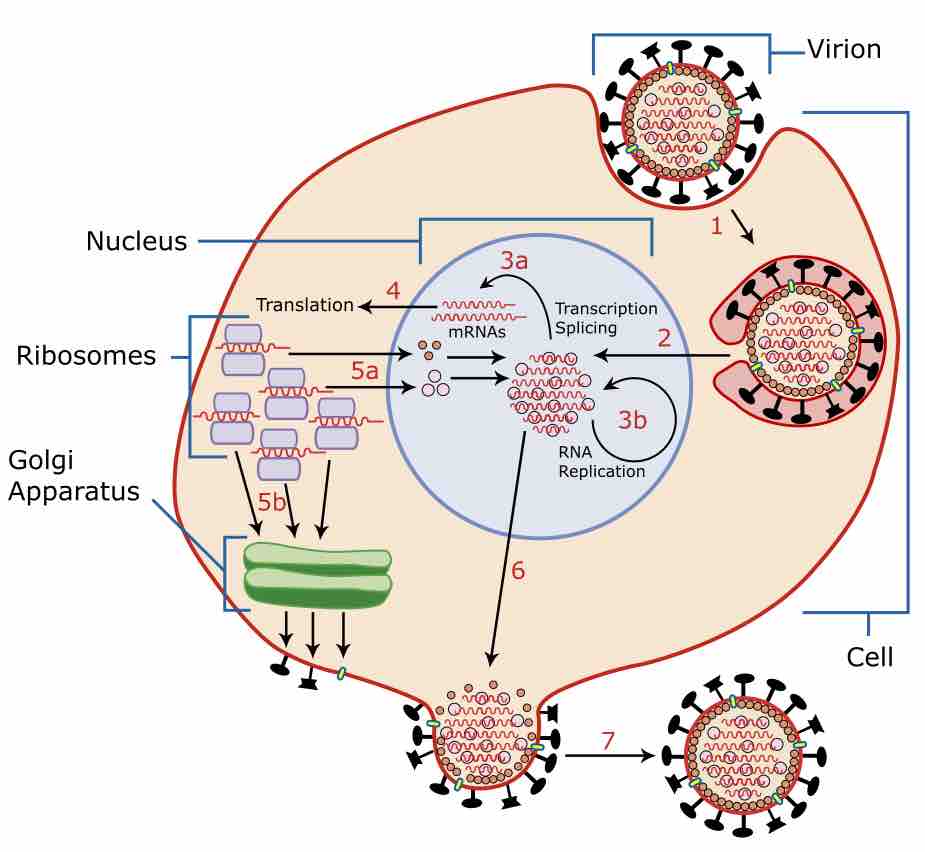Influenza A follows the typical life cycle of most influenza viruses. The infection and replication is a multi-step process:
- Binding to and entering the cell
- Delivering the genome to a site where it can produce new copies of viral proteins and RNA
- Assembling these components into new viral particles
- Exiting the host cell
Influenza viruses bind through hemagglutinin onto sialic acid sugars on the surfaces of epithelial cells, typically in the nose, throat, and lungs of mammals, and the intestines of birds (Step 1 in infection figure ). After the hemagglutinin is cleaved by a protease, the cell imports the virus by endocytosis.

Influenza replication cycle
Host invasion and replication cycle of an influenza virus. Step 1: Binding Step 2: Entry Step 3: Complex formation and transcription Step 4: Translation Step 5: Secretion Step 6: Assembly Step 7: Release
The intracellular details are still being worked out. It is known that virions converge to the microtubule organizing center, interact with acidic endosomes, and finally enter the target endosomes for genome release. Once inside the cell, the acidic conditions in the endosome cause two events to happen:
- The hemagglutinin protein fuses the viral envelope with the vacuole's membrane.
- The M2 ion channel allows protons to move through the viral envelope and acidify the core of the virus, which causes the core to dissemble and release the viral RNA and core proteins.
The viral RNA (vRNA) molecules, accessory proteins, and RNA-dependent RNA polymerase are then released into the cytoplasm (Step 2 in figure). These core proteins and vRNA form a complex that is transported into the cell nucleus, where the RNA-dependent RNA polymerase begins transcribing complementary positive-sense vRNA (Steps 3a and b in figure).
The vRNA either enters into the cytoplasm and translated (Step 4) or remains in the nucleus. Newly synthesized viral proteins are either secreted through the Golgi apparatus onto the cell surface (in the case of neuraminidase and hemagglutinin, Step 5b) or transported back into the nucleus to bind vRNA and form new viral genome particles (Step 5a).
Other viral proteins have multiple actions in the host cell—including degrading cellular mRNA and using the released nucleotides for vRNA synthesis, and also inhibiting translation of host-cell mRNAs.
Negative-sense vRNAs that form the genomes of future viruses, RNA-dependent RNA polymerase, and other viral proteins are assembled into a virion. Hemagglutinin and neuraminidase molecules cluster into a bulge in the cell membrane. The vRNA and viral core proteins leave the nucleus and enter this membrane protrusion (Step 6). The mature virus buds off from the cell in a sphere of the host phospholipid membrane, acquiring hemagglutinin and neuraminidase with this membrane coat (Step 7). As before, the viruses adhere to the cell through hemagglutinin; the mature viruses detach once their neuraminidase has cleaved sialic acid residues from the host cell. Drugs that inhibit neuraminidase, such as oseltamivir, therefore prevent the release of new infectious viruses and halt viral replication. After the release of new influenza viruses, the host cell dies.